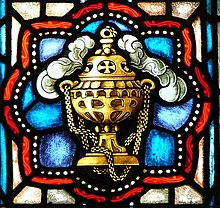
Back شورية Arabic Encenser Catalan Kadidelnice Czech Weihrauchfass German Incensario Spanish Suitsuti Estonian Intsentsu-ontzi Basque Encensoir French Wijreekfet Frisian Tömjénfüstölő Hungarian



A thurible (via Old French from Medieval Latin turibulum) is a metal incense burner suspended from chains, in which incense is burned during worship services. It is used in Christian churches, including the Roman Catholic, Eastern Orthodox, Assyrian Church of the East and Oriental Orthodox, Church of England as well as in some Lutheran, Old Catholic, United Methodist, Reformed, Presbyterian Church USA, and Anglican churches (with its use almost universal amongst Anglo Catholic Anglican churches). In Roman Catholic, Lutheran, and Anglican churches, the altar server who carries the thurible is called the thurifer. The practice is rooted in the earlier traditions of Judaism dating from the time of the Second Jewish Temple.[1]
Beyond its ecclesiastical use, the thurible is also employed in various other spiritual or ceremonial traditions, including some Gnostic Churches, Freemasonry[2] (especially in the consecration of new lodges), and in Co-Freemasonry. Thuribles are sometimes employed in the practice of ceremonial magic.[3][4]
The workings of a thurible are quite simple. Each thurible consists of a censer section, chains (typically three or four, although single-chain thuribles also exist), a metal ring around the chains (used to lock the lid of the censer section in place), and usually (although not always) a removable metal crucible in which the burning charcoals are placed. Many thuribles are supplied with a stand, allowing the thurible to be hung safely when still hot, but not in use. Burning charcoal is placed inside the metal censer, either directly into the bowl section, or into a removable crucible if supplied, and incense (of which there are many different varieties) is placed upon the charcoal, where it melts to produce a sweet smelling smoke. This may be done several times during the service as the incense burns quite quickly. Once the incense has been placed on the charcoal the thurible is then closed and used for censing.[1]
A famous thurible is the huge Botafumeiro in Santiago de Compostela Cathedral, Spain.[1]
- ^ a b c Herrera, Matthew D. Holy Smoke: The Use of Incense in the Catholic Church. San Luis Obispo: Tixlini Scriptorium, 2011.
- ^ Reference at Masonic Encyclopedia, by Albert G Mackey.
- ^ Michno, Dennis G. (1998). "The Holy Eucharist-Concerning the Use of Incense at the Eucharist". A Priest's Handbook - The Ceremonies of the Church. Harrisburg, PA: Moorehouse Publishing. ISBN 0-8192-1768-9.
- ^ Crowley, Aleister (1997). "Chapter XVI: The Magick Fire; With Considerations of the Thurible, the Charcoal, and the Incense". Magick. York Beach, ME: Samuel Weiser. ISBN 0-87728-919-0.